Wolf and Bear Depredation on Livestock in Northern Sweden 1827–2014: Combining History, Ecology and Interviews
Abstract
:1. Introduction
1.1. Summer Farming in Sweden
1.2. Carnivores in Sweden
1.3. Carnivores, Livestock, Local and Traditional Knowledge
1.4. Research Questions
- (1)
- How has the risk of depredation (livestock killed by carnivores) changed since the second half of the nineteenth century?And
- (2)
- Has local and traditional knowledge of how to protect livestock from predation survived until the present?
2. Materials and Methods
2.1. Number of Carnivores
2.2. Numbers of Livestock
2.3. Depredation on Livestock 1876–1930 and 1999–2014
2.4. Interviews with Summer Farmers
3. Results
3.1. Number of Carnivores
3.2. Number of Livestock
3.3. Depredation on Livestock, 1876–1930 and 1999–2014
3.4. Interviews with Summer Farmers
3.4.1. Experience of Carnivore Encounters
3.4.2. Traditional Knowledge
3.4.3. New Knowledge and Preventive Measures
4. Discussion
4.1. Depredation Rates
4.2. Local and Traditional Knowledge of Protecting Livestock from Carnivores
4.3. Management of Livestock in Carnivore Areas
Acknowledgments
Author Contributions
Conflicts of Interest
Ethical Statement
Appendix A
| Id-code Main Occupation | LiveStock | Products, Sources of Income | Carnivore Encounters Since | Behavior of Livestock with Carnivores | Behavior Carnivores | Actions to Prevent Attacks | Carnivore Knowledge, Where From? | Proposals for Management | Long Term Effects of Carnivores |
|---|---|---|---|---|---|---|---|---|---|
| Dalarna | |||||||||
| A Farmer | 40 cattle, 30 sheep, 12 goats, chickens pigs, horses | Milk, meat, bio-cultural values | Bears 1995, wolves 2004 | Cows afraid and aggressive, attack humans. Break up in small groups, hard to find, avoid farm. Lower milk production, poorer quality. Lower fecundity. | Wolves and bears unafraid. Attack any time. Seem to know the area around farm well. | Keep livestock night stabled. Teach them safe paths. Remove carnivore hiding places. Keep experienced breeds. Salt stone in safe area. | From hunters, read old books with stories about carnivores. | Quick protective hunt. | Stopped summer farming, partly because of carnivores |
| B Farmer | 65 cattle | Meat, biological values | Bears 2002, wolves 2012 | Cattle observant, move in tight groups, notice presence of wolves at once. Experienced cattle show the others attack sites. Lower fecundity. Avoid certain areas, results inloss of grazing. | Wolves come closer to farms than many think, tracks very close to summer farm | Timing of summer grazing season to avoid bears (not too early) and wolves (not too late). Night corrals. Put human scent on livestock (but wolves do not care) | Own experience. Information on fencing from CAB, and Wildlife Damage Centre. | Quick protective hunt More dialogue CAB—farmers. Full compensation for extra costs. | |
| C Goat farmer, dairy worker, projects | 4 cattle, 3 calves, 32 goats | Meat, milk, cheese, courses, biological values | - | Goats become watchful. Important to have experienced goats in flock. Avoid dense vegetation. | Carnivores intelligent, seem to learn where livestock go. | Night stabling. Let goats choose where to graze, herding part of time. Keep livestock that trust me. Keep noisy goats. Keeping calves at farmstead and letting calves suckle in afternoon make cows come to farm. | Information on fencing from Wildlife Damage Centre. | Quick protective hunt, GPS on livestock. Access to search dogs | |
| D Farmer | 80 sheep before, now 30–40 cattle | Meat, biological values | Bears since the end of the 1980s | Sheep easily killed, surviving sheep have lower fecundity. Cattle flee long distances, difficult to find. | Bears took 94 sheep, once one bear took 20 sheep. | Night corral & fenced field. Stopped keeping sheep and do not keep calves at summer farm | Own experience. | Quick protective hunt | Stopped keeping sheep at summer farm |
| E Part-time farmer | 120 sheep lambs | Meat, wool, pelts, biological values | Bears 1995, wolves 1997/1999 | Livestock become shy, watchful, do not eat enough. Loss of production. | Wolves incredibly effective, unafraid, know where to hide | Night corral and electric fences | Own experience. Information on fencing from CAB. | Quick protective hunt | Stopped summer farming |
| F Farmer, forestry, multiple areas of income | 23 cattle plus calves, 30–35 goats, horses, pigs | Milk, butter, cheese, meat, bio-cultural values | Wolves 2009 | Swedish mountain cattle breed and experienced cows keep watch, wait and smell before deciding where to graze. Udder inflammations, still-born calves. Sheep clueless. | Wolves move on bogs, forest roads; bears appear anywhere; | Livestock stabled at night; GPS on livestock. Carnivore safe fence at home farm. | Learnt from other summer farmers with experience. Information on fencing from CAB. | Quick protective hunt. Dogs are not safe with tourists. Pigs might be tried as watchdogs. | |
| G Farmer | 7 cattle, 15 sheep, goats, horses | Meat, household milk, biological values | Bears 2000, Wolf 2001 | Only sheep have been attacked, usually young ewes, often with bells or lambs of ewes with bells. | Bears hide in forest, use heights for overview. Wolf problem ceased after hunting. | Animals stabled at night and fences. Several large bears have been shot. Breeding male wolf was killed and young wolf killed earlier. | Wildlife Damage Centre, CAB, other farmers. | Quick protective hunt. Herding dogs are not safe with tourists. | |
| H Goat farmer | 70 goats | Milk | Bears 2001 | The goats stay close to the farm. | Bears close to human homes | Keeping livestock close to farm | - | Quick protective hunt | |
| Jämtland | |||||||||
| A Farmer | 60–80 goats, 36 sheep. | Milk, cheese, meat, pelts, courses, bio-cultural values | Bears 2005 | Goats become very watchful, stay on high terrain. Loss of milk and fecundity, many still-born the year after attack, damaged udders. Cows often still and listen. | Bears hide in dense vegetation near farm, unafraid. Bears teach each other. | Night shelter. Important to study cow behavior. Care when handling goats to avoid injury from their horns (started to butt with their heads after attacks) | Other farmers, Wildlife Damage Centre and Järvzoo. No info from CAB, police even when asked for. | Quick protective hunt. Need for livestock shelters and acute help. | Moved to new summer farm |
| B Milk farmer, some tourism | 20 cattle | Milk, cheese, meat, eco-tourism | Bears 1995 | Cows avoided certain areas for a week or so after attack, co-existed with bear. Now a different bear that attacks cows. | Some bears do not attack, others do | Livestock stabled at night. Herd them out in the morning. Carnivore safe fence. Used to have sheep at summer farm. | Other farmers, Wildlife Damage Centre, CAB. | Quick protective hunt. More dialogue and compensation. | Stopped keeping sheep at summer farm |
| C Wood worker, sheep farmer | 30 cattle 50 sheep horse, pigs, chickens | Milk, meat, bio-cultural values, knowledge | Bears 1995 | Cattle avoid large area, loss of grazing land. Flock stressed, ran back to summer farm on some occasions | - | Livestock kept stabled at night. Sheep fenced with electric carnivore safe fences, used to roam free. | 99% from my parents, and they from their parents. | More dialogue and compensation for preventive actions. | Stopped letting sheep roam free |
| D Milk farmer, ranger, tourism | Cattle, goats, chickens | Milk, cheese, meat, eco-tourism | Long term yearly bear encounter but no attack, 2011 probably wolf | 2011 cattle frightened in new way, 10 cows lost calves Considerable milk loss. Probably wolf. | Bear passes in July every year, peaceful co-existence with cows | Livestock fenced, stabled at night. | In training for park ranger, additional courses Swedish Environmental Protection Agency | Quick protective hunt, spring hunt on bears. | Stopped keeping sheep at summer farm |
References
- Liberg, O.; Aronson, Å.; Brainerd, S.M.; Karlsson, J.; Pedersen, H.-C.; Sand, H.; Wabakken, P. The recolonizing Scandinavian Wolf population: Research and management in two countries. In The World of Wolves: New Perspectives on Ecology, Behaviour and Management; Musiani, M., Boitani, L., Paquet, P.C., Eds.; University of Calgary Press: Calgary, AB, USA, 2010. [Google Scholar]
- Sand, H.; Liberg, O.; Flagstad, Ø.; Wabakken, P.; Åkesson, M.; Karlsson, J.; Ahlqvist, P. Den Skandinaviska Vargen—En Sammanställning av Kunskapsläget Från det Skandinaviska Vargforskningsprojektet SKANDULV 1998–2014, Grimsö Forskningsstation, SLU; Rapport till Direktoratet for Naturforvaltning, Trondheim, Norge. 2014. (In Swedish). Available online: https://www.regjeringen.no/globalassets/upload/kld/kl/klima-og-skogprosjektet/skandulv.pdf (accessed on 9 August 2017).
- Chapron, G.; Kaczensky, P.; Linnell, J.D.C.; von Arx, M.; Huber, D.; Andren, H.; Vicente Lopez-Bao, J.; Adamec, M.; Alvares, F.; Anders, O.; et al. Recovery of large carnivores in Europe’s modern human-dominated landscapes. Science 2014, 346, 1517–1519. [Google Scholar] [CrossRef] [PubMed]
- Bisi, J.; Kurki, S.; Svensberg, M.; Liukkonen, T. Human dimensions of wolf (Canis lupus) conflicts in Finland. Eur. J. Wildl. Res. 2007, 53, 304–314. [Google Scholar] [CrossRef]
- Dorresteijn, I.; Hanspach, J.; Kecskes, A.; Latkova, H.; Mezey, Z.; Sugar, S.; von Wehrden, H.; Fischer, J. Human-carnivore coexistence in a traditional rural landscape. Landsc. Ecol. 2014, 29, 1145–1155. [Google Scholar] [CrossRef]
- Kojola, I.; Aspi, J.; Hakala, A.; Heikkinen, S.; Ilmoni, C.; Ronkainen, S. Dispersal in an expanding wolf population in Finland. J. Mammal. 2006, 87, 281–286. [Google Scholar] [CrossRef]
- Zlatanova, D.; Ahmed, A.; Valasseva, A.; Genov, P. Adaptive Diet Strategy of the Wolf (Canis lupus L.) in Europe: A Review. Acta Zool. Bulg. 2014, 66, 439–452. [Google Scholar]
- Kaartinen, S.; Luoto, M.; Kojola, I. Carnivore-livestock conflicts: Determinants of wolf (Canis lupus) depredation on sheep farms in Finland. Biodivers. Conserv. 2009, 18, 3503–3517. [Google Scholar] [CrossRef]
- Kardell, Ö. Om Rödluvan och vargen och den svenska vargdebatten. RIG Kult. Tidskr. 2008, 91. (In Swedish, with English summary). Available online: journals.lub.lu.se/index.php/rig/article/download/3742/3494 (accessed on 13 September 2017).
- Kardell, Ö.; Dahlström, A. Wolves in the Early Nineteenth-Century County of Jönköping, Sweden. Environ. Hist. 2013, 19, 339–370. [Google Scholar] [CrossRef]
- Myrdal, J. Boskapsskötseln under Medeltiden; En källpluralistisk studie; Nordiska Museets Förlag: Stockholm, Sweden, 2012. (In Swedish) [Google Scholar]
- Kardell, Ö. Swedish Forestry, Forest Pasture Grazing by Livestock, and Game Browsing Pressure since 1900. Environ. Hist. 2016, 22, 561–587. [Google Scholar] [CrossRef]
- Simmons, I.G. The world scale. Environ. Hist. 2004, 10, 531–536. [Google Scholar] [CrossRef]
- Myrdal, J.; Morell, M. (Eds.) The Agrarian History of Sweden. From 4000 BC to AD 2000; Nordic Academic Press: Lund, Sweden, 2011. [Google Scholar]
- Bele, B.; Norderhaug, A. Traditional land use of the boreal forest landscape: Examples from Lierne, Nord-TrOndelag, Norway. Norsk Geogr. Tidsskr.-Nor. J. Geogr. 2013, 67, 12–23. [Google Scholar] [CrossRef]
- Larsson, J. The expansion and Decline of a Transhumance system in Sweden, 1550–1920. Hist. Agrar. Revis. Agric. Hist. Rural 2012, 56, 11–39. [Google Scholar]
- Nyrén, U. Från utrotning till utbredning. Den svenska vargstammen som historiskt allmoge- och överhetsprojekt. Hist. Tidskr. 2012, 123, 365–391, (In Swedish with English summary). [Google Scholar]
- Hedén, A.-C. Fäbodnäringens Förutsättningar i Sverige. Utvärdering av Fäbodbruk, Fäboddrift och Utmarksbetet i Landsbygdsprogrammet 2007–2013; Länsstyrelsen Dalarnas län: Falun, Sweden, 2014. (In Swedish) [Google Scholar]
- Government Offices of Sweden. Sweden—Rural Development Programme (National) 2014–2020; Government Offices of Sweden: Stockholm, Sweden, 2016; (In Swedish). Available online: http://www.jordbruksverket.se/download/18.229ea55815233ba0390e8c59/1452694447806/Landsbygdsprogrammet+2014–2020.pdf (accessed on 9 August 2017).
- Austrheim, G.; Olsson, E.G.A.; Grontvedt, E. Land-use impact on plant communities in semi-natural sub-alpine grasslands of Budalen, central Norway. Biol. Conserv. 1999, 87, 369–379. [Google Scholar] [CrossRef]
- Austrheim, G.; Eriksson, O. Recruitment and life-history traits of sparse plant species in subalpine grasslands. Can. J. Bot.-Rev. Can. Bot. 2003, 81, 171–182. [Google Scholar] [CrossRef]
- Olsson, E.G.A.; Austrheim, G.; Grenne, S.N. Landscape change patterns in mountains, land use and environmental diversity, Mid-Norway 1960–1993. Landsc. Ecol. 2000, 15, 155–170. [Google Scholar] [CrossRef]
- Olsson, E.G.A.; Hanssen, S.; Rønningen, K. Different conservation values of biological diversity? A case study from the Jotunheimen mountain range, Norway. Norsk Geogr. Tidsskr. Nor. J. Geogr. 2004, 58, 204–212. [Google Scholar] [CrossRef]
- Rodriguez-Ortega, T.; Oteros-Rozas, E.; Ripoll-Bosch, R.; Tichit, M.; Martin-Lopez, B.; Bernues, A. Applying the ecosystem services framework to pasture-based livestock farming systems in Europe. Animal 2014, 8, 1361–1372. [Google Scholar] [CrossRef] [PubMed]
- Tunon, H.; Axelsson Linkowski, W.; Kvarnström, M.; Wissman, J.; Bele, B.; Norderhaug, A. To view a landscape: Reflections upon the governance of Scandinavian transhumance. Balt. World 2013, VI, 53–60. [Google Scholar]
- Wilson, D.E.; Mittermeier, R.A. (Eds.) Handbook of the Mammals of the World—Volume 1; Lynx Edicions: Barcelona, Spain, 2009. [Google Scholar]
- Lönnberg, E. Björnen i Sverige 1856–1928; Almqvist & Wiksell: Uppsala/Stockholm, Sweden, 1929. (In Swedish) [Google Scholar]
- Lönnberg, E. Bidrag till Vargens Historia i SVERIGE. In Kungl. Svenska Vetenskapsakademiens Skrifter i Naturskyddsärenden; Svenska Vetenskapsakademiens: Stockholm, Sweden, 1934. (In Swedish) [Google Scholar]
- Anon. Inventering av lodjur 2015. Bestandsstatus för Stora Rovdjur i Skandinavien 2-2015; Rovdata, Trondheim, Norway and Viltskadecenter: Grimsö, Sweden, 2015; (In Swedish). Available online: http://www.nina.no/archive/nina/PppBasePdf/Bestandsstatus%20for%20store%20rovdyr%20i%20Skandinavia/2-2015.pdf (accessed on 9 August 2017).
- Brøseth, H.; Eklund, A. (Eds.) Inventering av Järv 2015. Bestandsstatus för Stora Rovdjur i Skandinavien 3-2015; Rovdata, Trondheim, Norway and Viltskadecenter: Grimsö, Sweden, 2015; (In Swedish). Available online: https://brage.bibsys.no/xmlui/handle/11250/2375476 (accessed on 13 September 2017).
- Swenson, J.E.; Wabakken, P.; Sandegren, F.; Bjärvall, A.; Franzén, R.; Söderberg, A. The near extinction and recovery of brown bears in Scandinavia in relation to the bear management policies of Norway and Sweden. Wildl. Biol. 1995, 1, 11–25. [Google Scholar]
- Kindberg, J.; Swenson, J.E. Björnstammens Storlek i Sverige 2013—Länsvisa Skattningar och Trender; Rapport 2014-2 Från Det Skandinaviska Björnprojektet. 2014; (In Swedish). Available online: http://bearproject.info/wp-content/uploads/2015/11/2014-E121-2-Bj%C3%B6rnstammens-storlek-i-Sverige-2013.pdf (accessed on 9 August 2017).
- Wabakken, P.; Sand, H.; Liberg, O.; Bjärvall, A. The recovery, distribution, and population dynamics of wolves on the Scandinavian peninsula, 1978–1998. Can. J. Zool. 2001, 79, 710–725. [Google Scholar] [CrossRef]
- Anon. Inventering av Varg Vintern 2014–2015. Inventeringsresultat för Stora Rovdjur i Skandinavien 1-2015; Rovdata og Viltskadecenter: Evenstad, Norway and Grimsö, Sweden, 2015. (In Swedish) [Google Scholar]
- Wabakken, P.; Svensson, L.; Maartmann, E.; Åkesson, M.; Flagstad, Ø. Beståndsovervåkning av ulv Vinteren 2015–2016. Beståndsstatus for Store Rovdyr i Skandinavia 1-2016. Rovdata Evenstad, Norway and Viltskadecenter: Grimsö, Sweden, 2016. (In Norwegian and Swedish). Available online: http://hdl.handle.net/11250/2390916 (accessed on 9 August 2017).
- Proposition 2012/13:191. En Hållbar Rovdjurspolitik. (Governmental Bill 2012/13:191. A Sustainable Predator Policy). (In Swedish). Available online: http://www.regeringen.se/contentassets/af7ef44fdcb8410bbadbbd117e033ced/en-hallbar-rovdjurspolitik-prop.-201213191 (accessed on 9 August 2017).
- SOU 2012:22 Mål för Rovdjuren (Government Official Investigation 2012:22). (In Swedish). Available online: http://www.regeringen.se/49bba8/contentassets/0b53f6bc5d98440e94767dbe37c59a0b/mal-for-rovdjuren-sou-201222-hela (accessed on 29 August 2017).
- Sahlén, V.; Swenson, J.; Brunberg, S.; Kindberg, J. Björnen i Sverige. En Rapport Från Skandinaviska Björnprojektet till den Svenska Rovdjursutredningen; Skandinaviska Björnprojektet Rapport 2006-4. 2006. (In Swedish). Available online: http://www.naturogat.se/rovdjur_pdf/060401_bjornen_i_sverige.pdf (accessed on 9 August 2017).
- Jedrzejewska, B.; Jedrzejewski, W.; Bunevich, A.N.; Milkowski, L.; Okarma, H. Population dynamics of wolves Canis lupus in Bialowieza primeval forest (Poland and Belarus) in relation to hunting by humans, 1847–1993. Mamm. Rev. 1996, 26, 103–126. [Google Scholar] [CrossRef]
- Kikvidze, Z.; Tevzadze, G. Loss of traditional knowledge aggravates wolf–human conflict in Georgia (Caucasus) in the wake of socio-economic change. Ambio 2015, 44, 452–457. [Google Scholar] [CrossRef] [PubMed]
- Molnár, Z. Traditional Ecological Knowledge of Herders on the Flora and Vegetation of the Hortobágy; Hortobágy Természetvédelmi Közalapítvány: Debrecen, Hungary, 2012. [Google Scholar]
- Molnár, Z.; Kis, J.; Vadász, C.; Papp, L.; Sándor, I.; Béres, S.; Sinka, G.; Varga, A. Common and conflicting objectives and practices of herders and nature conservation managers: The need for a conservation herder. Ecosyst. Health Sustain. 2016, 2, e01215. [Google Scholar] [CrossRef]
- Österling, P.A. Dialekt och folkminnesarkivens material—Etnologi på Institutet för språk och folkminnen (SOFI) exemplet ULMA. In Nycklar till Kunskap. Om Människans Bruk av Naturen; Tunon, H., Dahlström, A., Eds.; Centrum för Biologisk Mångfald: Uppsala Sweden; Kungl, Skogs-och Lantbruksakademien: Stockholm, Sweden, 2010; pp. 59–66. (In Swedish) [Google Scholar]
- Berkes, F.; Colding, J.; Folke, C. Rediscovery of traditional ecological knowledge as adaptive management. Ecol. Appl. 2000, 10, 1251–1262. [Google Scholar] [CrossRef]
- Food and Agriculture Organization of the United Nations. What is local knowledge? In Building on Gender, Agrobiodiversity and Local Knowledge; FAO: Rome, Italy, 2004; pp. 7–13. Available online: http://www.fao.org/docrep/013/i2050e/i2050e.pdf (accessed on 13 September 2017).
- International Council for Science/Conseil International pour la Science March. Science and Traditional Knowledge and Sustainable Development; ICSU Series on Science for Sustainable Development. No. 4. 2002. Available online: http://unesdoc.unesco.org/images/0015/001505/150501eo.pdf (accessed on 9 August 2017).
- Gómez-Baggethun, E.; Reyes-García, V. Reinterpreting Change in Traditional Ecological Knowledge. Hum. Ecol. 2013, 41, 643–647. [Google Scholar] [CrossRef] [PubMed]
- Oteros-Rozas, E.; Ontillera-Sanchez, R.; Sanosa, P.; Gómez-Baggethun, E.; Reyes-Garcia, V.; Gonzalez, J.A. Traditional ecological knowledge among transhumant pastoralists in Mediterranean Spain. Ecol. Soc. 2013, 18, 33. [Google Scholar] [CrossRef]
- Winiwarter, V.; Armiero, M.; Van Dam, P.; Dix, A.; Eliasson, P.; Holm, P.; Jelečk, L.; Lambert, R.A.; Massard-Guilbaud, G.; De Molina, M.G.; et al. Environmental History in Europe from 1994 to 2004: Enthusiasm and Consolidation. Environ. Hist. 2004, 10, 501–530. [Google Scholar] [CrossRef]
- Skogsstyrelsen/Statens domäner. Bidrag till Sveriges Officiella Statistik. Q Skogsväsendet 1870–1910; Norstedt & Söner: Stockholm, Sweden, 1872–1912. (In Swedish) [Google Scholar]
- Kungliga Domänstyrelsens Förvaltning. 1911–1965; Sveriges Officiella Statistik. Kungl. Domänstyrelsen; Norstedt & Söner: Stockholm, Sweden, 1912–1966. (In Swedish) [Google Scholar]
- Khalil, H.; Pasanen-Mortensen, M.; Elmhagen, B. The relationship between wolverine and larger predators, lynx and wolf, in a historical ecosystem context. Oecologia 2014, 175, 625–637. [Google Scholar] [CrossRef] [PubMed]
- Persson, J.H.; Sand, H. Vargen: Viltet, Ekologin och Människan; Brittas, R., Ed.; Svenska Jägareförbundet: Spånga, Sweden, 1998. (In Swedish) [Google Scholar]
- Viltskadecenter. 1998–2014. Varg i Skandinavien (Wolf in Scandinavia). Rovdata and Viltskadecenter: Evenstad, Norge; SLU: Grimsö, Sverige, 1999—2015; Available online: http://www.viltskadecenter.se/index.php?option=com_content&task=view&id=110&Itemid=881 (accessed on 9 August 2017).
- Hushållningssällskapen. Bidrag till Sveriges officiella statistik. N, Jordbruk och Boskapsskötsel, 1865–1911; Norstedt & Söner: Stockholm, Sweden, 1867–1912. [Google Scholar]
- Statistiska Centralbyrån. Sveriges Officiella Statistik. 1913–1963. Jordbruk och Boskapsskötsel; Statistiska Centralbyrån: Stockholm, Sweden, 1916–1964. (In Swedish) [Google Scholar]
- Jordbruksverket and Statistiska Centralbyrån. Jordbruksstatistisk Årsbok 1965–2000 (Statistical Yearbook of Agriculture); Jordbruksverket and Statistiska Centralbyrån: Jönköping, Sweden, 1965–2000. (In Swedish) [Google Scholar]
- Jordbruksverket and Statistiska Centralbyrån. Jordbruksstatistisk Årsbok 2001–2014; Jordbruksverket and Statistiska centralbyrån: Jönköping, Sweden, 2001-2014. (In Swedish) [Google Scholar]
- Viltskadecenter. Viltskadestatistik 2003–2014. (Statistics of Damage Caused by Wildlife; Wildlife Damage Centre: Riddarhyttan, Sweden, 2004–2015; (In Swedish). Available online: http://www.viltskadecenter.se/index.php?option=com_content&task=view&id=110&Itemid=881#publikationervarg (accessed on 9 August 2017).
- Morell, M. Jordbruket i Industrisamhället; Natur och Kultur; LTs Förlag: Stockholm, Sweden, 2001. (In Swedish) [Google Scholar]
- Flygare, I.A.; Isacson, M. Jordbruket i Välfärdssamhället; Natur och Kultur; LTs Förlag: Örebro, Sweden, 2003. (In Swedish) [Google Scholar]
- Vicente Lopez-Bao, J.; Kaczensky, P.; Linnell, J.D.C.; Boitani, L.; Chapron, G. Carnivore coexistence: Wilderness not required. Science 2015, 348, 871–872. [Google Scholar] [CrossRef] [PubMed]
- Hacquebord, L. Three Centuries of Whaling and Walrus hunting in Svalbard and its Impact on the Arctic Ecosystem. Environ. Hist. 2001, 7, 169–185. [Google Scholar] [CrossRef]
- Lelli, B.; Harris, D.E.; Aboueissa, A.-M. Seal Bounties in Maine and Massachusetts, 1888 to 1962. Northeast. Nat. 2009, 16, 239–254. [Google Scholar] [CrossRef]
- Wikenros, C.; Sand, H.; Bergström, R.; Liberg, O.; Chapron, G. Response of Moose Hunters to Predation following Wolf Return in Sweden. PLoS ONE 2015, 10. [Google Scholar] [CrossRef] [PubMed]
- Zimmermann, B.; Sand, H.; Wabakken, P.; Liberg, O.; Andreassen, H.P. Predator-dependent functional response in wolves: From food limitation to surplus killing. J. Anim. Ecol. 2015, 84, 102–112. [Google Scholar] [CrossRef] [PubMed] [Green Version]
- Linnell, J.D.C.; Broseth, H.; Odden, J.; Nielsen, E.B. Sustainably harvesting a large carnivore? Development of Eurasian lynx populations in Norway during 160 years of shifting policy. Environ. Manag. 2010, 45, 1142–1154. [Google Scholar] [CrossRef] [PubMed]
- Lidberg, J. Slutrapport Från Projektet Fäbodbete och Rovdjur i Dalarna. Miljövårdsenheten Rapport 2007:15; Länsstyrelsen i Dalarnas län: Falun, Sweden, 2007. (In Swedish) [Google Scholar]
- Zimmermann, B.; Wabakken, P.; Dötterer, M. Brown Bear–Livestock Conflicts in a Bear Conservation Zone in Norway: Are Cattle a Good Alternative to Sheep? Ursus 2003, 14, 72–83. [Google Scholar]
- Steyaert, S.; Stoen, O.G.; Elfström, M.; Karlsson, J.; Van Lammeren, R.; Bokdam, J.; Zedrosser, A.; Brunberg, S.; Swenson, J.E. Resource selection by sympatric free-ranging dairy cattle and brown bears Ursus arctos. Wildl. Biol. 2011, 17, 389–403. [Google Scholar] [CrossRef]
- Gómez-Baggethun, E.; Corbera, E.; Reyes-García, V. Traditional Ecological Knowledge and Global Environmental Change: Research findings and policy implications. Ecol. Soc. 2013, 18, 72. [Google Scholar] [CrossRef] [PubMed]
- Fernández-Giménez, M.E.; Estaque, F.F. Pyrenean Pastoralists’ Ecological Knowledge: Documentation and Application to Natural Resource Management and Adaptation. Hum. Ecol. 2012, 40, 287–300. [Google Scholar] [CrossRef]
- Rigg, R.; Findo, S.; Wechselberger, M.; Gorman, M.L.; Sillero-Zubiri, C.; Macdonald, D.W. Mitigating carnivore-livestock conflict in Europe: Lessons from Slovakia. Oryx 2011, 45, 272–280. [Google Scholar] [CrossRef]
- Mackinson, S. Integrating local and scientific knowledge: An example in fisheries science. Environ. Manag. 2001, 27, 533–545. [Google Scholar] [CrossRef]
- Hernández-Morcillo, M.; Hoberg, J.; Oteros-Rozas, E.; Plieninger, T.; Gómez-Baggethun, E.; Reyes-Garcia, V. Traditional Ecological Knowledge in Europe Status Quo and Insights for the Environmental Policy Agenda. Environment 2014, 56, 3–17. [Google Scholar] [CrossRef]
- Kis, J.; Barta, S.; Elekes, L.; Engi, L.; Fegyver, T.; Kecskeméti, J.; Lajkó, L.; Szabó, J. Traditional herders´ knowledge and worldview and their role in managing biodiversity and ecosystem services of extensive pastures. In Indigenous and Local Knowledge of Biodiversity and Ecosystem Services in Europe and Central Asia; Knowledges of Nature 9; Roué, M., Molnár, Z., Eds.; UNESCO: Paris, France, 2016; pp. 57–71. Available online: http://climatefrontlines.org/sites/default/files/ipbes/IPBES_in_Europe_and_Central_Asia_2016.pdf (accessed on 9 August 2017).
- Sutherland, W.J.; Gardner, T.A.; Haider, L.J.; Dicks, L.V. How can local and traditional knowledge be effectively incorporated into international assessments? Oryx 2014, 48, 1–2. [Google Scholar] [CrossRef]
- Zimmermann, B.; Wabakken, P.; Dötterer, M. Human–carnivore interactions in Norway: How does the re-appearance of large carnivores affect people’s attitudes and levels of fear? For. Snow Landsc. Res. 2001, 76, 137–153. [Google Scholar]
- Cinque, S. I Vargens Spår. Myndigheternas Handlingsutrymme i Förvaltning av Varg. Ph.D. Thesis, School of Public Administration and University of Gothenburg, Gothenburg, Sweden, 2008. (In Swedish with English summary). [Google Scholar]
- Rondinini, C.; Boitani, L. Systematic conservation planning and the cost of tackling conservation conflicts with large carnivores in Italy. Conserv. Biol. 2007, 21, 1455–1462. [Google Scholar] [CrossRef] [PubMed]

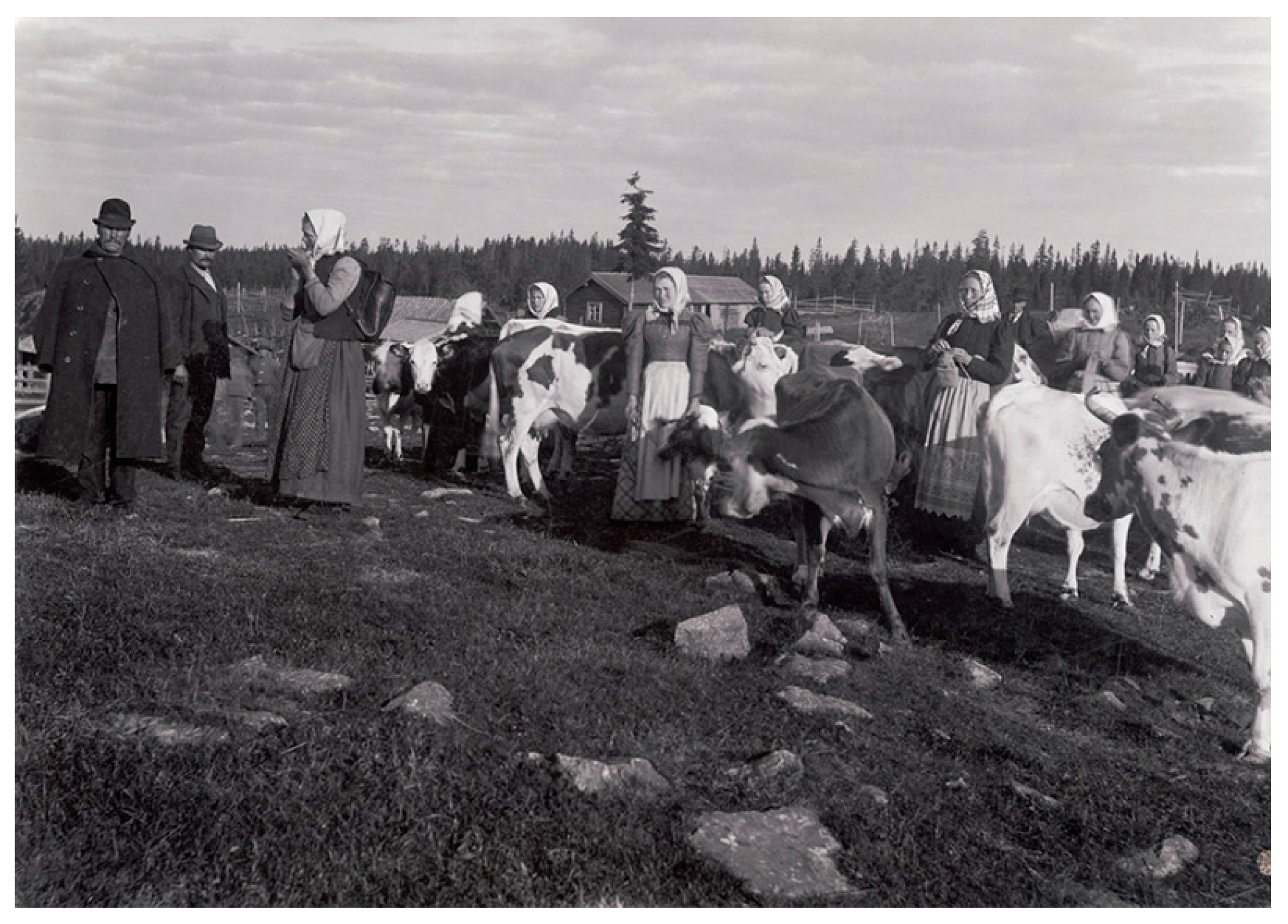
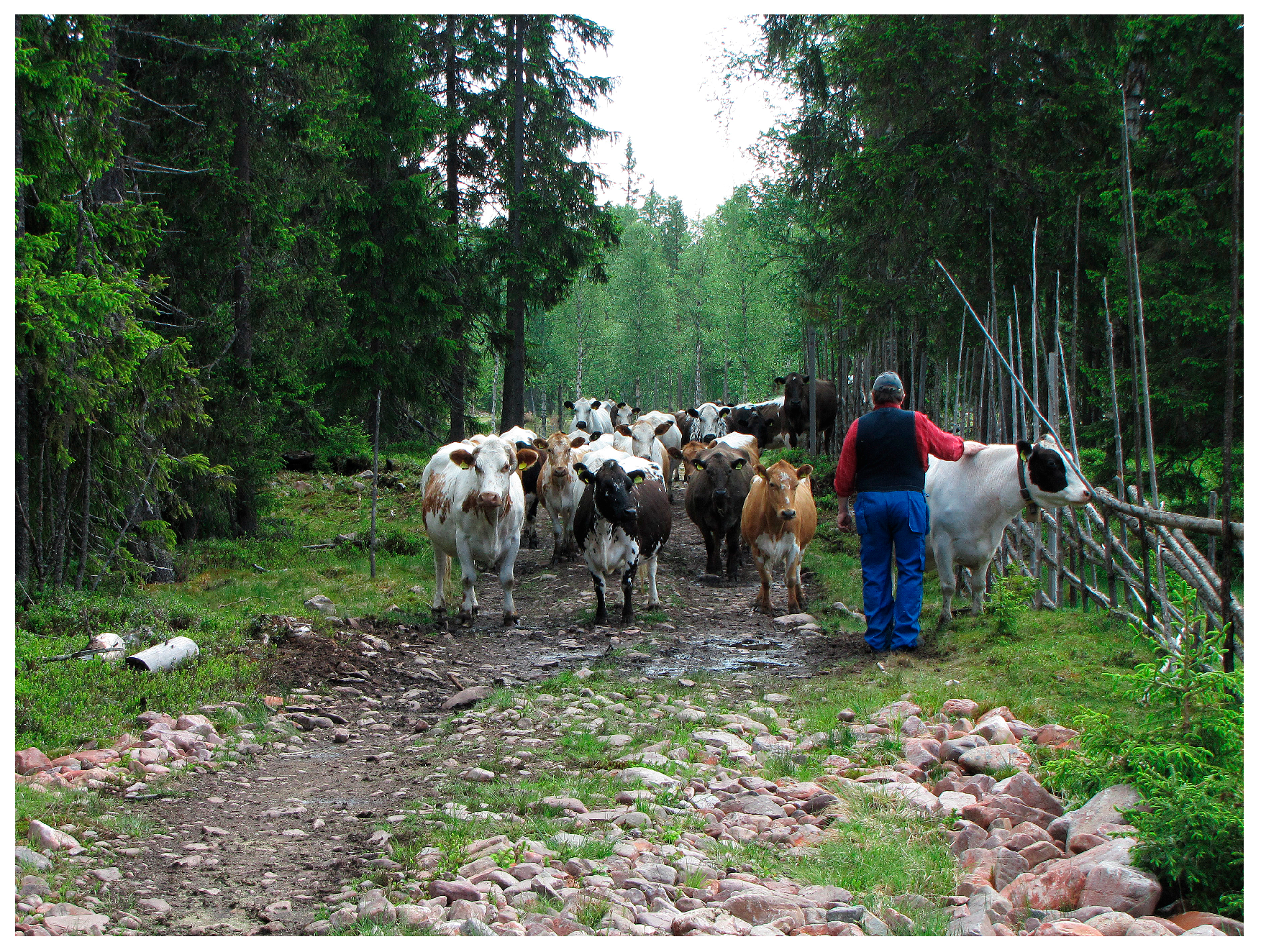
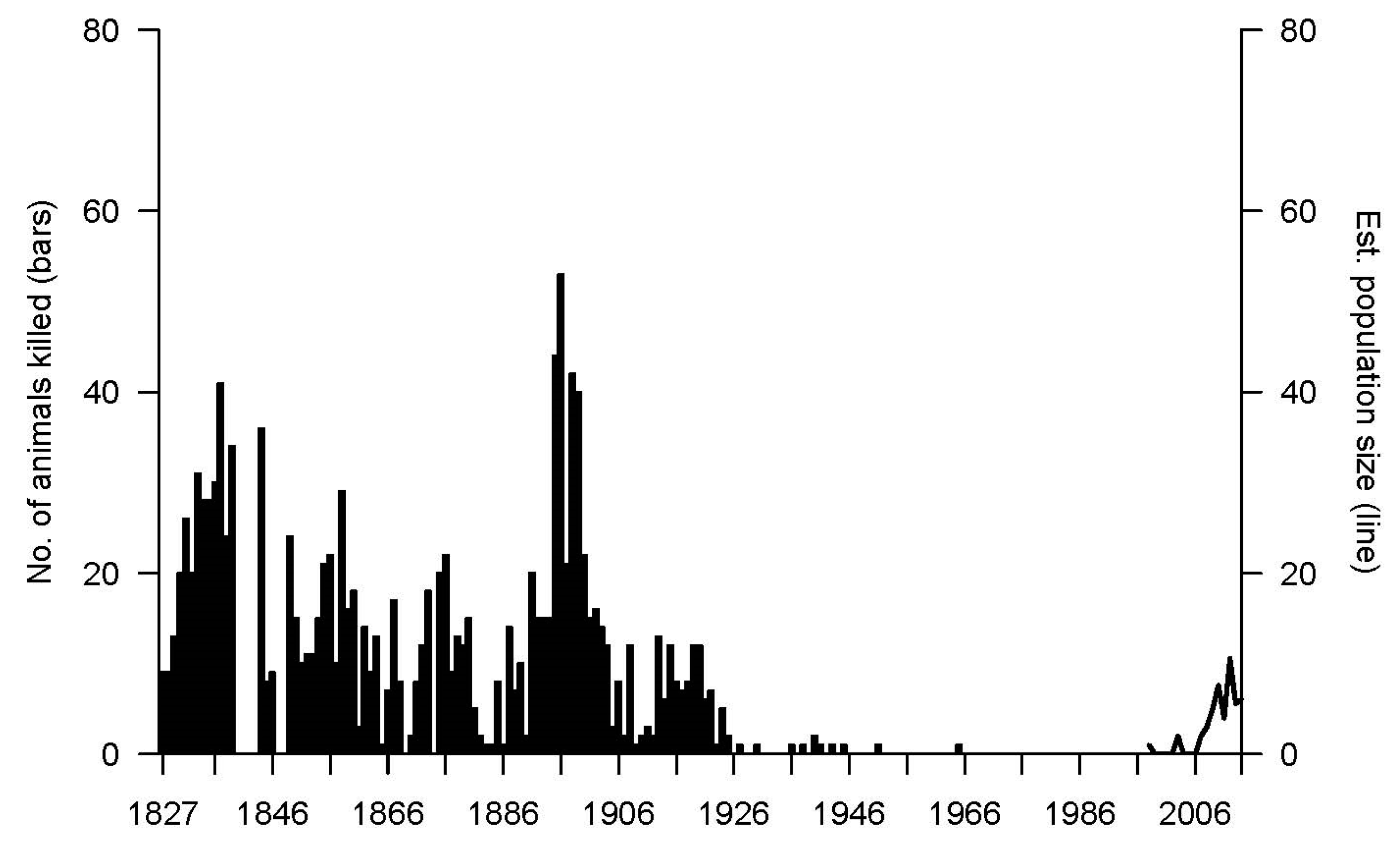
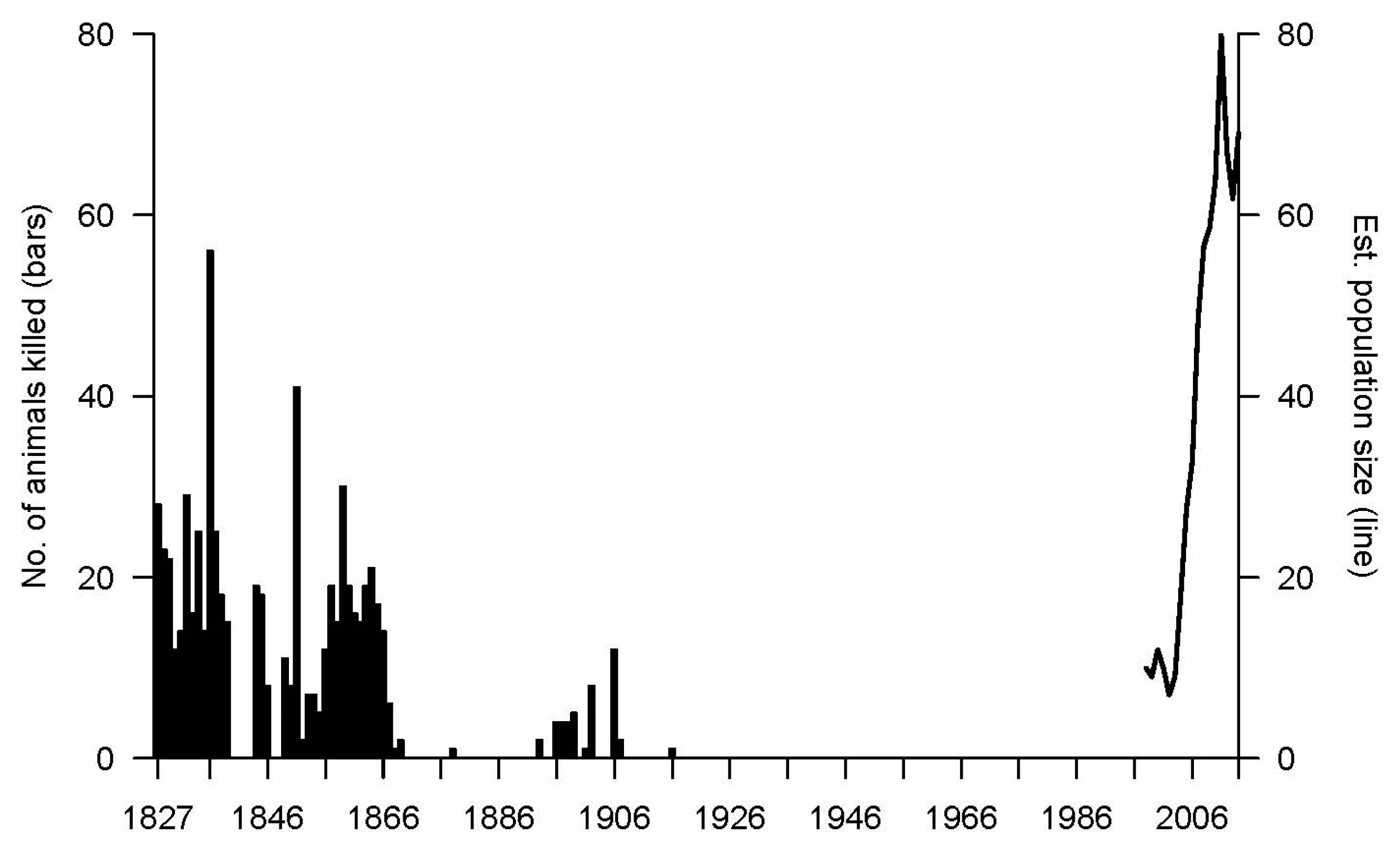
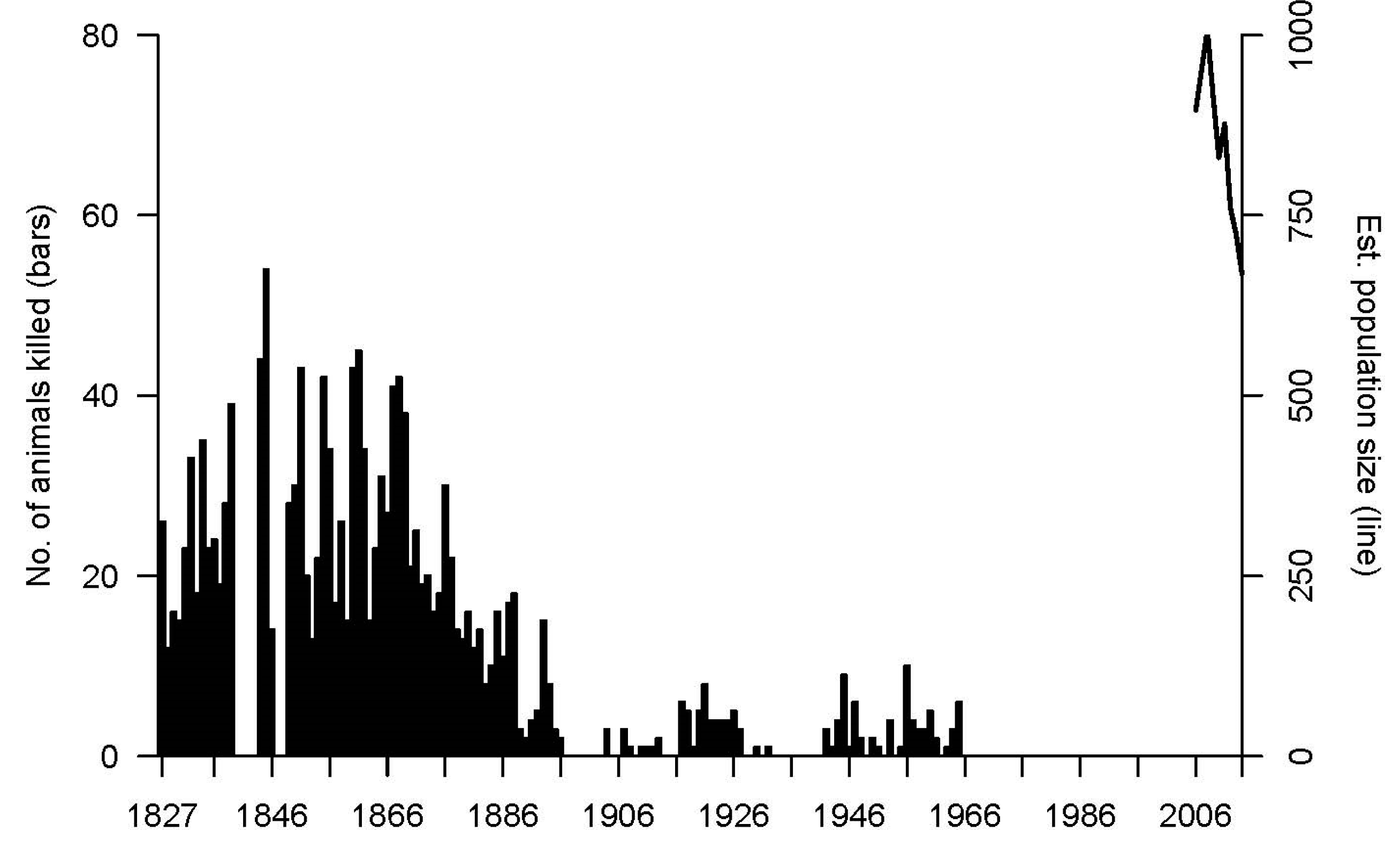
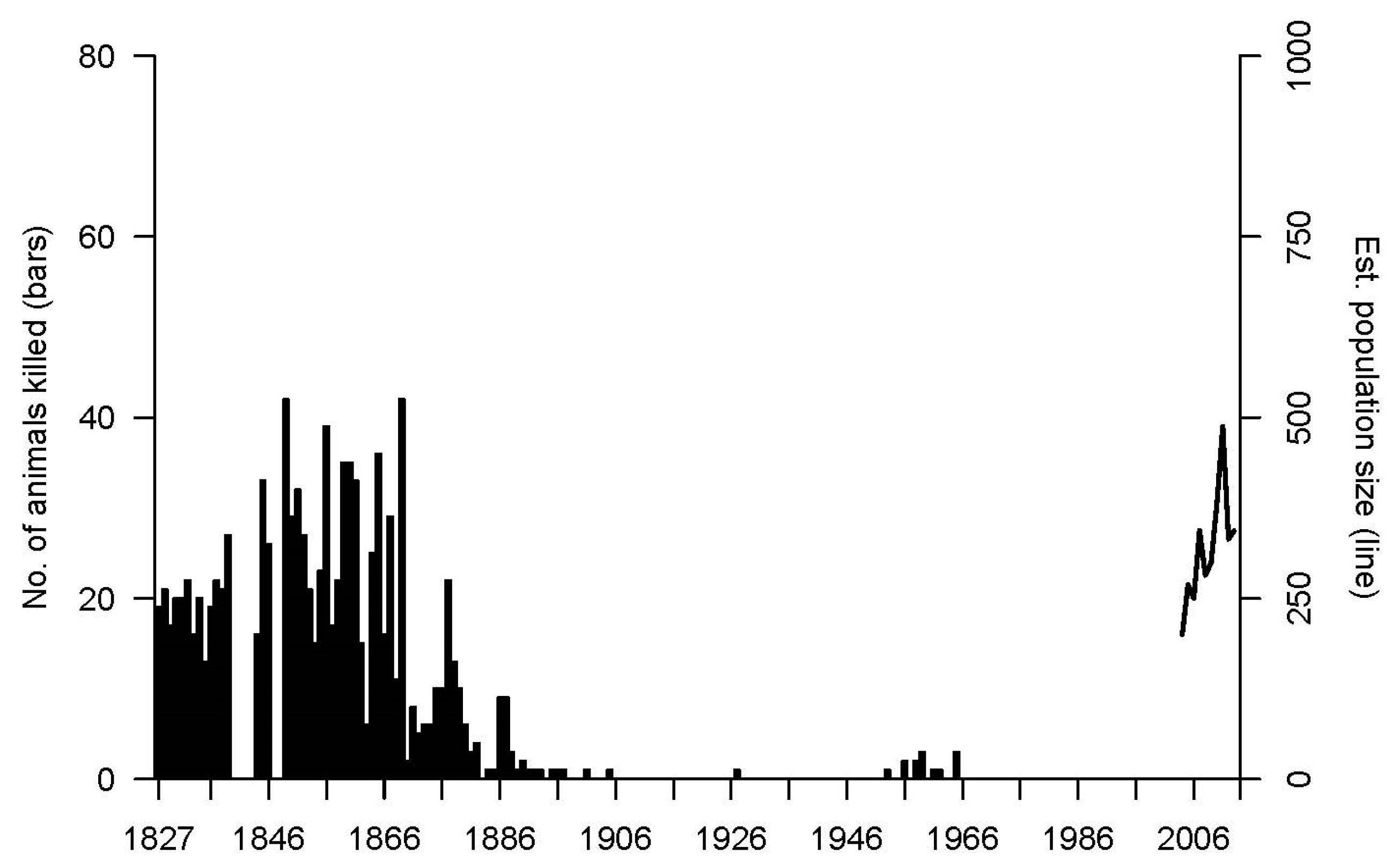
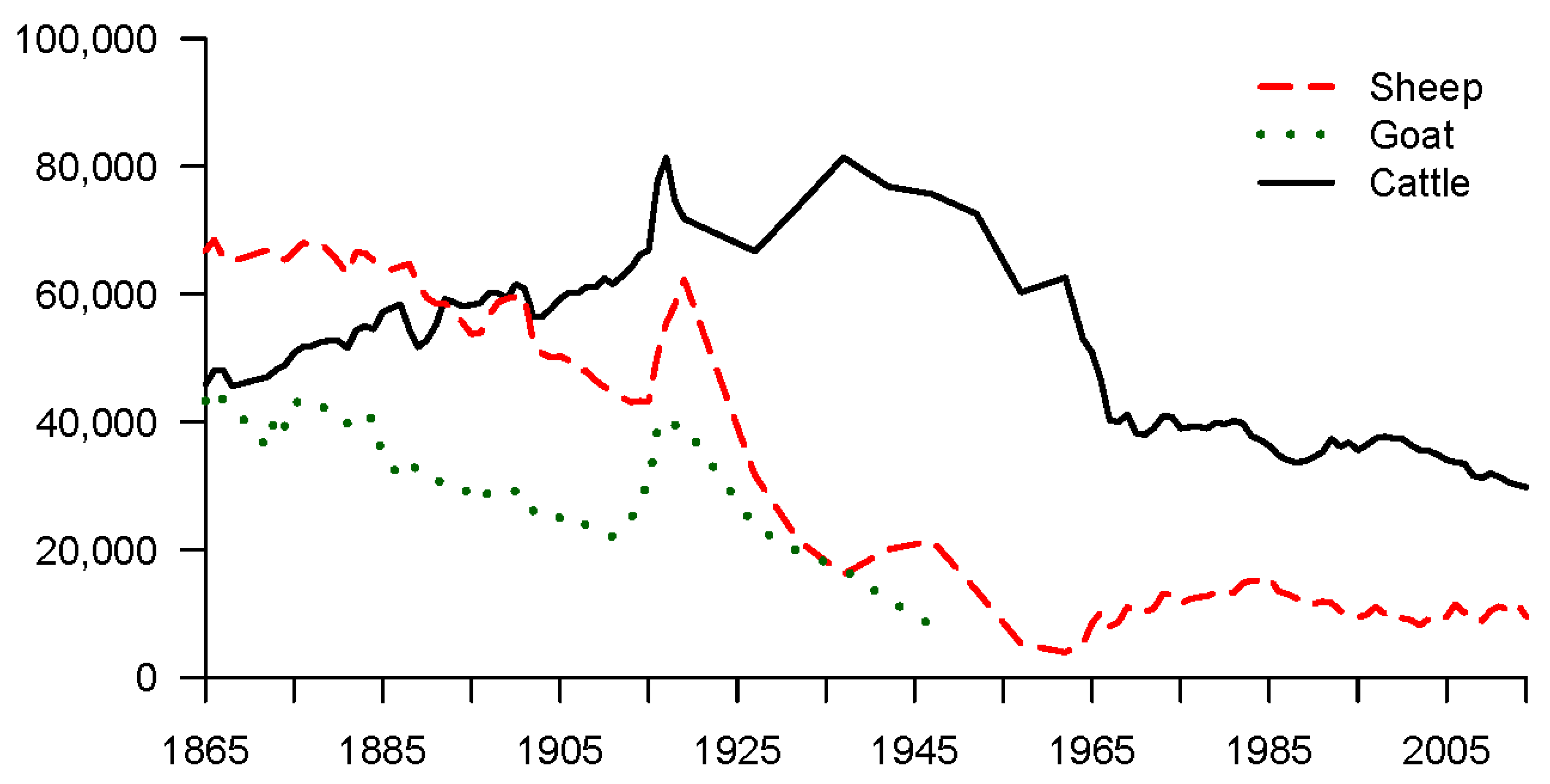
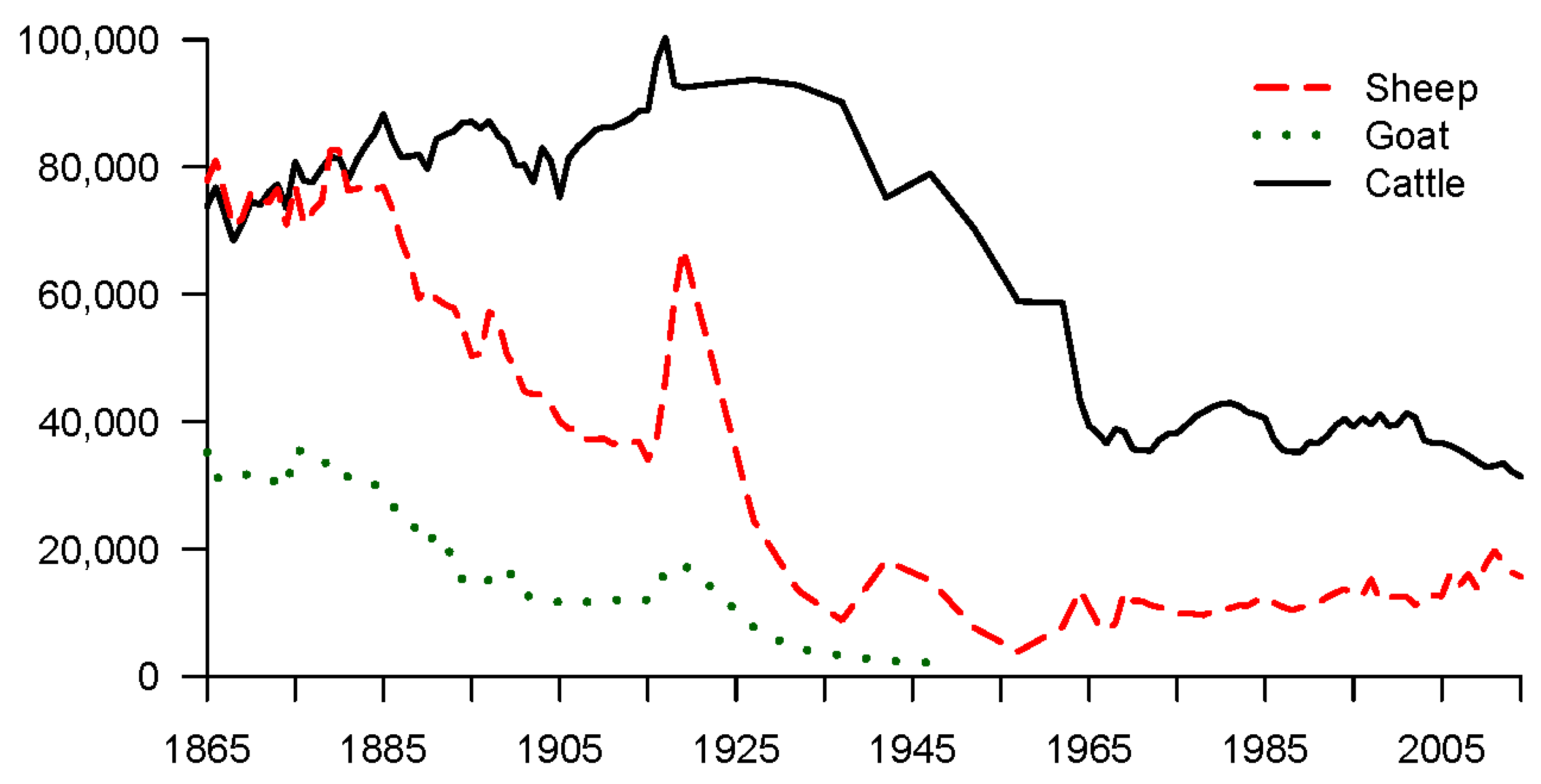
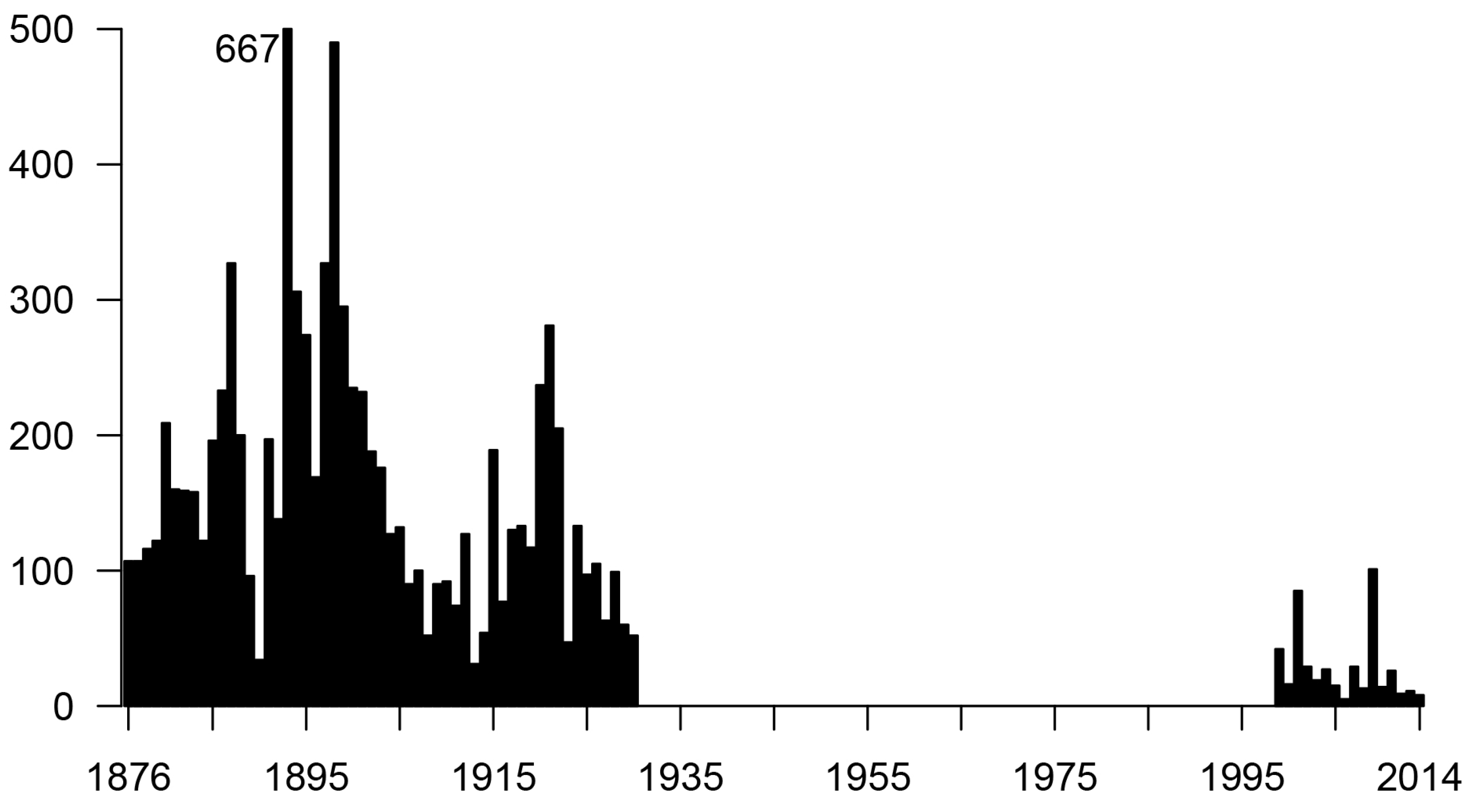

| County | Jämtland | Dalarna | ||||
|---|---|---|---|---|---|---|
| Year | Cattle | Goats | Sheep | Cattle | Goats | Sheep |
| 1876–1930 | 121 | 708 | 8205 | 45 | 183 | 2182 |
| Annual mean | 1.9 | 10.9 | 126.2 | 0.7 | 2.8 | 33.6 |
| 1999–2014 | 23 | 5 | 421 | 47 | 11 | 1021 |
| Annual mean | 1.5 | 0.3 | 28.1 | 3.1 | 0.7 | 68.1 |
| County | Jämtland | Dalarna | ||
|---|---|---|---|---|
| Year | Cattle | Sheep | Cattle | Sheep |
| 1876–1891 | 0.009% | 0.21% | 0.003% | 0.098% |
| 1999–2014 | 0.004% | 0.28% | 0.008% | 0.430% |
© 2017 by the authors. Licensee MDPI, Basel, Switzerland. This article is an open access article distributed under the terms and conditions of the Creative Commons Attribution (CC BY) license (http://creativecommons.org/licenses/by/4.0/).
Share and Cite
Axelsson Linkowski, W.; Kvarnström, M.; Westin, A.; Moen, J.; Östlund, L. Wolf and Bear Depredation on Livestock in Northern Sweden 1827–2014: Combining History, Ecology and Interviews. Land 2017, 6, 63. https://doi.org/10.3390/land6030063
Axelsson Linkowski W, Kvarnström M, Westin A, Moen J, Östlund L. Wolf and Bear Depredation on Livestock in Northern Sweden 1827–2014: Combining History, Ecology and Interviews. Land. 2017; 6(3):63. https://doi.org/10.3390/land6030063
Chicago/Turabian StyleAxelsson Linkowski, Weronika, Marie Kvarnström, Anna Westin, Jon Moen, and Lars Östlund. 2017. "Wolf and Bear Depredation on Livestock in Northern Sweden 1827–2014: Combining History, Ecology and Interviews" Land 6, no. 3: 63. https://doi.org/10.3390/land6030063





